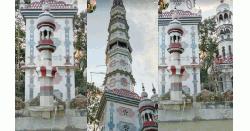| HEADLINE: |
|
Test, test and test – what’s the best?
Sheikh Mohammed Fazle Akbar and Mamun Al Mahtab
|
 Test, test and test – what’s the best? Several types of kits have been developed to date for assessing immunoglobulins M and G (IgM and IgG) of SARS-CoV-2 with regulatory approval either in hand or in the pipeline with the expectation that these will be commercially available within days or weeks. So, the question that naturally comes to mind is what will be the implication of these kits for the detection, containment, accumulation of evidence and epidemiological analysis of SARS-CoV-2 in national and global perspective. As we discussed these issues with friends and colleagues with medical, scientific and epidemiological backgrounds informally, we realised that these need to be discussed in more details for better understanding of the general public as well as for those many who are endowed with the opportunity to advise the policymakers. For our better understanding, we must understand what the presence of SARS CoV-2 antibody kit of an individual signifies? If IgG SARS-CoV-2 is detected in the serum of an individual, that can have several interpretations. The individual may have been infected with SARS-CoV-2 at some point of life or fairly recently, may be few weeks earlier. The question remains if a person is protected from further infection with SARS-CoV-2 due to presence of this antibody or is equally prone to be infected again with SARS-CoV-2 like any other individual. The common perception that IgG SARS-CoV-2 is protective from further infection with the virus lacks scientific evidence as of today. And very importantly this one piece of misinterpretation of IgG SARS-CoV-2 positivity can shatter the entire approach of public health delivery system and SARS-CoV-2 control programme of the country and eventually may drive it to a disaster. To justify the above statement on scientific basis, we need to understand how antibody of IgG type may be developed in SARS-CoV-2 infection. Once SARS-CoV-2 enters the human body, it sends “danger signal” or “non-self-signal” allowing different types of host immunocytes to mobilise at the site of infection. This is followed by polarisation, localisation and replication of immunocytes. The same events also take place in lymphoid tissue and lymph nodes of the host. There is cross-talk between virus, viral antigens, antigen-presenting cells, MHC class II and other inflammatory mediators of the host’s body, including cytokines and chemokines and possibly several other factors at immunological synapses. These interactions of the host’s immune system lead to the production of SARS-CoV-2-specific antibody, usually initially of IgM type and later of IgG type. The duration needed for formation of IgG type antibody to microbes is variable. Usually three to six weeks may be considered to be optimum. As of this moment, no data about implications of antibody to SARS-Cov-2 is available in this regard. Thus, we can obviously expect that SARS-CoV-2 would by now be detectable in many Bangladeshis, given the fact that over 80 percent of those who get the infection remain asymptomatic. However, there is no scientific evidence to show that SARS-CoV-2 is protective in nature. Accordingly, SARS-CoV-2 is a marker of previous infection. Whether this is protective or not can only be confirmed by future research and as of today, there is no evidence that it is of protective nature. If we assume that IgG SARS-CoV-2 is not of protective nature, it may explain the fallacies associated with this infection, namely asymptomatic infection and re-infection, the so called “dilemma of positive, negative and then again positive”. We should also consider some relevant information. A particular virus can have several antigens and IgG would develop to many or all of these antigens after variable periods, post-infection. For example, hepatitis B virus (HBV) has four or five prominent antigens namely, HBsAg, HBeAg, HBcAg, HBxAg, HB Pol-antigen. All HBV infected individuals express IgG antibody to HBcAg; several HBV-infected individuals also express to HBeAg. There is sparse information about antibodies to HBxAg and HB Pol-antigen and epidemiological studies have also not been accomplished, as these antigens are of limited clinical importance. However, neither anti-HBc nor anti-HBe are protective in nature and anyone harbouring these antibodies in serum may also harbour variable amount of HBV DNA. This has been shown and proved by several studies at international levels and also we have reconfirmed these facts in Bangladesh during the last decade. The only antibody that provides protection from HBV is anti-HBs. On the other hand, in case of hepatitis C virus or HCV infection, anti-HCV IgG represents an infective antibody and has been used for long time to diagnose patients who have HCV infection. However, IgG SARS-CoV-2 is the product of an acute viral infection that, unlike HBV and HCV, does not cause chronic disease and therefore may behave differently. So, without further complicating this discussion, the message that we would like to put forward is clear. There is urgent need to characterise the protective antigens of SARS-CoV-2 and antibodies to the virus. As soon as this target antigen is achieved, development of effective vaccine against SARS-CoV-2 will be a matter of time. Optimisation of a vaccine for human use usually takes several months, but in this case, this will be reduced by fast recruitment of volunteers. It is evident that several antibody kits will get permission from regulatory bodies of in no time. However, it has to be understood that these can be used for policy compilation. By no means it should be assumed that IgG antibody to SARS-CoV-2 is a protective one. The use of antibody kits in Bangladesh should be evaluated scientifically and we do not see any justification to introduce these in Bangladesh hurriedly. Recent graph from G7 countries indicate that we may have to wait for one or two more difficult month(s) before the infection curve takes a downward shift. It is still a realistic option that Bangladesh may not have to face such a paradigm and we may be able to get rid of the severe situation within similar time period despite our limited resources. SARS-CoV-2 may run the course of infection-reinfection-appearance-disappearance for another two to three years, until we get an effective vaccine. If we introduce the rapid antibody-based test kits in Bangladesh, there is strong possibility of introducing a false sense of protection or satisfaction as the nature of the antibody is yet to be clarified. Our main focus on the short term will be on strict implementation of physical distancing, which may have to be in effect for more than a year in some form. At the same time, we have to gradually step up our capability of patient care so that the number of deaths can be minimised. The later largely depends on the strength of health services. Lessons may be learnt from the US and Italy, where the high death toll represents some inherent deficit of health care delivery system, for example lack of insurance of certain population. In addition, higher percentage of elderly population, smoking and alcohol consumption and perhaps BCG vaccination may have also contributed, although the later one is still uncertain and remains to be assessed. IgM is the first antibody that appears after a viral infection usually within a week or so or may be even after days. Then there is antibody class-switching leading to formation of IgG. Japanese Nobel Laureate Professor Tasuku Honjo has accomplished several pioneering works on the issue. One of us, the co-authors of this article, Sheikh Mohammed Fazle Akbar also demonstrated class switching of IgG sub-classes in liver cirrhosis back in 1989. It is a reality that virus-specific IgM is used to detect many viral infections such as dengue and other viruses. It is a fallacy as to why IgM type antibodies to some viruses represent recent infection and why that is not true in others. This indicates the necessity of characterising the antigens of the SARS-Cov-2 virus as early as possible. If serodiagnosis becomes a reality, we can get the diagnosis of viral infection by enzyme-linked immunosorbent assay or ELISA. For example, in case of hepatitis A (HAV) and B viruses (HBV), diagnosis is conducted by the presence of anti-HAV IgM and anti-HBc IgM in serum respectively, without HAV RNA and HBV DNA detection by PCR. Accordingly, one can suggest that anti-SARS Cov-2 IgM testing can be used to pick up patients and therefore we can omit the PCR procedure. However, we have to keep in mind that if we want to use IgM antibody against a viral antigen for diagnostic purpose, we have to first identify the viral antigen that will be appropriate for the diagnosis process. The minimum criteria for such IgM antibody test are that the IgM has to show correlation with viral RNA or DNA titre in case of RNA and DNA viruses respectively. Unfortunately, in case of COVID-19, this is yet to be shown. So first we have to characterise the antigens and open reading frames of the virus and then develop IgM kit for early diagnosis of COVID-19. Only in that case we shall have a reliable test that will be able to diagnose COVID-19 in short time. Right now, scientists are working on this agenda. However, we must also remember that such antigens could not be retrieved in many viral infections and IgM based tests ultimately could not be developed in such cases. So, the question that can be validly raised is – what are these rapid test kits for? Why even some of the more developed nations are opting for these? The answer is simple – to assess the extent of the disease in the society following social spread of the virus. And yes – the kits may also be employed for diagnosis, but in that case a positive IgG to SARS-CoV-2 test must be followed by a PCR confirmation of infectivity. Similarly, symptomatic patients testing negative for IgM SARS-CoV-2 will also require PCR confirmation before they can be declared truly not infected. To our opinion, these rapid test kits will only add to the confusion and be of little or no help whatsoever. And, it is neither a priority nor is it expected at this moment. However, we are not opposing validation of antibody kit in Bangladesh with PCR outcome of SARS-CoV-2. We are in a war and we believe that there is only one leader no other than Prime Minister Sheikh Hasina in this war, one method of diagnosis which is PCR for the time being and one prevention strategy that is physical distancing. Writers: Sheikh Mohammed Fazle Akbar is a researcher at the Ehime University in Japan.
Mamun Al Mahtab (Shwapnil), a hepatologist, is currently working as the chairman of the Hepatology Department at the Bangabandhu Sheikh Mujib Medical University. |
Latest News
Popular News
Editor: Dr. Kazi Ertaza Hassan
All right reserved
South Western Media Group
© Daily Peoples Time
News & Commercial Office:93, Kazi Nazrul Islam Avenue, Kawran Bazar, Dhaka-1215
Phone: 88-02-41010087, 41010086, Fax: 88-02-41010085, Advertising: 88-02-41010084
E-mail: [email protected]








 The anti-Sheikh Hasina brigade has been paid back fair
The anti-Sheikh Hasina brigade has been paid back fair  Badruzzaman Badrul, the expatriate son of a brave martyr
Badruzzaman Badrul, the expatriate son of a brave martyr  Minar-e Kabir is a minaret located in Sugandia village
Minar-e Kabir is a minaret located in Sugandia village  Bashundhara Group, the country’s largest business conglomerate, has been
Bashundhara Group, the country’s largest business conglomerate, has been 



